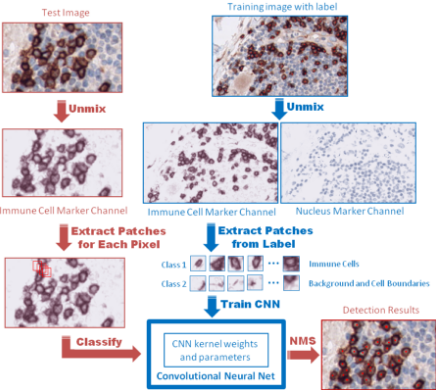Source for picture: click here
Python
- Theano is a python library for defining and evaluating mathematical expressions with numerical arrays.
- Keras is a minimalist, highly modular neural network library in the spirit of Torch, written in Python, that uses Theano under the hood for optimized tensor manipulation on GPU and CPU.
- Pylearn2 is a library that wraps a lot of models and training algorithms such as Stochastic Gradient Descent that are commonly used in Deep Learning.
- Lasagne is a lightweight library to build and train neural networks in Theano.
- Blocks a framework that helps you build neural network models on top of Theano.
- Caffe is a deep learning framework made with expression, speed, and modularity in mind.
- nolearn contains a number of wrappers and abstractions around existing neural network libraries, most notably Lasagne, along with a few machine learning utility modules.
- Gensim is deep learning toolkit implemented in python programming language intended for handling large text collections, using efficient algorithms.
- Chainer bridge the gap between algorithms and implementations of deep learning.
- deepnet is a GPU-based python implementation of deep learning algorithms like Feed-forward Neural Nets, Restricted Boltzmann Machines, Deep Belief Nets, Autoencoders, Deep Boltzmann Machines and Convolutional Neural Nets.
- Hebel is a library for deep learning with neural networks in Python using GPU acceleration with CUDA through PyCUDA.
- CXXNET is fast, concise, distributed deep learning framework based on MShadow.
- DeepPy is a Pythonic deep learning framework built on top of NumPy.
- DeepLearning is deep learning library, developed with C++ and python.
- Neon is Nervana’s Python based Deep Learning framework.
Matlab
- ConvNet Convolutional neural net is a type of deep learning classification algorithms, that can learn useful features from raw data by themselves and is performed by tuning its weighs.
-
DeepLearnToolBox is a matlab/octave toolbox for deep learning and includes Deep Belief Nets, Stacked Autoencoders, convolutional neural nets.
-
cuda-convnet is a fast C++/CUDA implementation of convolutional (or more generally, feed-forward) neural networks. It can model arbitrary layer connectivity and network depth. Any directed acyclic graph of layers will do. Training is done using the backpropagation algorithm.
-
MatConvNet is a MATLAB toolbox implementing Convolutional Neural Networks (CNNs) for computer vision applications. It is simple, efficient, and can run and learn state-of-the-art CNNs
CPP
-
eblearn is an open-source C++ library of machine learning by New York University’s machine learning lab, led by Yann LeCun.
-
SINGA is designed to be general to implement the distributed training algorithms of existing systems.
-
NVIDIA DIGITS is a new system for developing, training and visualizing deep neural networks.
-
Intel® Deep Learning Framework provides a unified framework for Intel® platforms accelerating Deep Convolutional Neural Networks.
Java
-
N-Dimensional Arrays for Java (ND4J)is scientific computing libraries for the JVM.
-
Deeplearning4j is the first commercial-grade, open-source, distributed deep-learning library written for Java and Scala.
-
Encog is an advanced machine learning framework which supports Support Vector Machines,Artificial Neural Networks, Genetic Programming, Bayesian Networks, Hidden Markov Models, Genetic Programming and Genetic Algorithms are supported.
JavaScript
-
Convnet.js is a Javascript library for training Deep Learning models (mainly Neural Networks) entirely in a browser.
Lua
-
Torch is a scientific computing framework with wide support for machine learning algorithms.
Julia
-
Mocha is a Deep Learning framework for Julia, inspired by the C++ framework Caffe.
Lisp
-
Lush(Lisp Universal Shell) is an object-oriented programming language designed for researchers, experimenters, and engineers interested in large-scale numerical and graphic applications.
Haskell
-
DNNGraph is a deep neural network model generation DSL in Haskell.
.NET
- Accord.NET is a .NET machine learning framework combined with audio and image processing libraries completely written in C#.
R
- darch package can be used for generating neural networks with many layers (deep architectures).
- deepnet implements some deep learning architectures and neural network algorithms, including BP,RBM,DBN,Deep autoencoder and so on.
To read the full article and have more explanation, click here.
DSC Resources
- Career: Training | Books | Cheat Sheet | Apprenticeship | Certification | Salary Surveys | Jobs
- Knowledge: Research | Competitions | Webinars | Our Book | Members Only | Search DSC
- Buzz: Business News | Announcements | Events | RSS Feeds
- Misc: Top Links | Code Snippets | External Resources | Best Blogs | Subscribe | For Bloggers
Additional Reading
- What statisticians think about data scientists
- Data Science Compared to 16 Analytic Disciplines
- 10 types of data scientists
- 91 job interview questions for data scientists
- 50 Questions to Test True Data Science Knowledge
- 24 Uses of Statistical Modeling
- 21 data science systems used by Amazon to operate its business
- Top 20 Big Data Experts to Follow (Includes Scoring Algorithm)
- 5 Data Science Leaders Share their Predictions for 2016 and Beyond
- 50 Articles about Hadoop and Related Topics
- 10 Modern Statistical Concepts Discovered by Data Scientists
- Top data science keywords on DSC
- 4 easy steps to becoming a data scientist
- 22 tips for better data science
- How to detect spurious correlations, and how to find the real ones
- 17 short tutorials all data scientists should read (and practice)
- High versus low-level data science
Follow us on Twitter: @DataScienceCtrl | @AnalyticBridge

